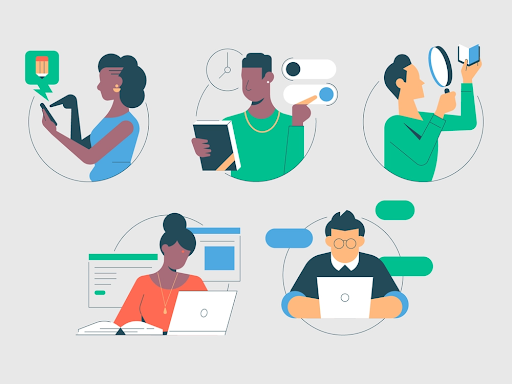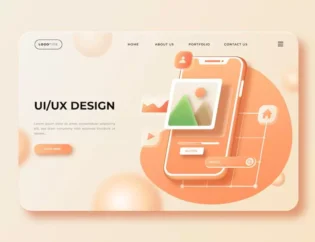
Mobile Application
Excerpt: A detailed explanation of software development. Breaking each concept into simpler terms to make you understand the ABC of software development cost. Then move towards the ways to reduce your software development cost.
Read Time: 12 mins 30 seconds
Software development often seems to be a complicated process with lots of effort going in. Often people from the software or IT industry would tell you that it takes a long time to build software and heavy work goes behind it. For non-techies, it’s a huge board of meandering criss-cross lines. We are here to simplify that for you.
How Does A Software Development Process Look Like?
Often a software development is called software development lifecycle (SDLC). It has 7 stages:
1. Analysis and Planning:

In this stage, it is simply taking inputs from the stakeholders and domain experts. Here the planning happens with the requirement list and identification of the risks of the project. Mostly it is the business analyst and the project organiser who sets up the meeting with the client to gather all data because, before product building, a core understanding of the product is very essential.
2. Requirements

Understanding the technical requirements of the project is the core here. Representing and documenting the software requirements happens. Then getting accepted by the stakeholders. This is performed using the “SRS”-Software Requirement Specification document, which covers all of the product requirements that must be built and developed during the project life cycle.
3. Designing

It’s time to design the software. This decides how the software will look and how it will work. No, no, we are not talking about aesthetics. We are talking about functionality and flow. This stage of the SDLC may entail creating simple wireframes to demonstrate how software interactions will operate, or creating full-fledged prototypes to test with people using a programme like Marvel or InVision. Alternatively, you may determine that more user feedback is required and conduct a design sprint to swiftly get a feature or concept in front of your people.
4. Development

The actual development and programming begin at this level of the SDLC. Writing code is the first step in putting a design into action. Developers must adhere to their management’s coding rules, and programming tools such as compilers, interpreters, and debuggers are used to develop and implement the code.
5. Testing

The code is then evaluated against the criteria to ensure that the products are meeting the demands identified during the requirements stage.
Unit, integration, system, and acceptability testing are all performed during this stage.
6. Deployment

The software is deployed once it has been certified and no bugs or mistakes have been found. The software may then be distributed as is or with suggested enhancements in the object part, depending on the results of the assessment.
After the software has been deployed, it must be maintained.
7. Maintenance and Updates

The process has not ended yet. We call it a lifecycle, remember? Hence, client’s wants and requirements are constantly changing. People will uncover issues, seek new features, and desire more or different functionality when they begin to use your software. (Not to mention simple application or software upkeep and maintenance to assure uptime and client happiness.)
All of these requests should be redirected to the product backlog of tasks, where they may be prioritized and included in your product roadmap.
But what after building the software? After building it we must also look at how users find information about your product. Then we have to look at the information architecture of it.
What Is Information Architecture?
In simple words, the discipline of selecting how to arrange the pieces of something to make it understandable is known as information architecture. Information Architecture is everywhere. Information architectures (IAs) can be found on the websites we visit, in the apps and software we download, in printed documents we come across, and even in the actual spaces we visit.
The initial stage of the concept phase is often information architecture. It serves as the foundation for the navigation concept and wireframes, as well as giving an overview of the system’s content and operations. We use the information architecture to organise content and functions into categories that correspond to the tasks, the product’s perception, and the correct user terminology. At the same time, this framework aids in achieving your communication objectives. To this purpose, developing the information architecture is an iterative process in which changes and new functions can be added regularly.
Below we are giving an example of IA for an app
The diagram is taken from: https://blog.hubspot.com/website/information-architecture
This is not it. In software development, there’s another thing that you need to understand before moving to the main topic. It is called a Project Development Document. Let’s dive into it.
What is EdTech?
Edtech is a word that combines the terms education and technology. For the modern educational system, this unusual synthesis is a big game-changer. As classrooms grow more virtual, it’s critical to have a learner-centred approach.
The rapid growth of technology is supporting teachers in modifying course curricula. It is a win-win situation for both teachers and students when IT resources are used in the classroom. It improves the learning experience for students while also providing new opportunities for teachers.
Advantages of EdTech
- Students’ learning capacities have improved because of Advanced Tech. To learn at their own pace, students can schedule their classes. They are studying through a project-based approach, which aids in the development of their analytical abilities.
- With advances in virtual reality, education is no longer a textbook-based method, but rather a reflection of real-world abilities. Virtual reality-based education is engaging and encourages students to learn. Students capture everything in virtual surroundings because they are close replicas of real worlds.
- The necessity of the hour is for Edtech to bridge the gap between teachers and students. Online environments are more strategy-oriented; they emphasise time management, which helps students comprehend the significance of time-based learning.

7 Best EdTech Startups That That is Bringing the Change
1. Coursera

Coursera is an online learning platform for working people and students that was founded in the United States. Andrew Ng and Daphne Koller, both professors of computer science, created this company in 2012.
It has worked with over 200 universities to bridge the gap between traditional education and modern workplaces. With courses from universities such as the University of Michigan, Imperial College London, Yale, and others, this EdTech firm has made a reputation for itself. Coursera is currently enrolled by 70 million students.
Business Model
The Business-to-Customer (B2C) and Business-to-Business (B2B) models are used by Coursera. It addresses students and working professionals directly. It generates money by selling students online courses. Students who have purchased Coursera courses can access the course materials after they have completed the course. It has collaborations with several universities and institutions.
2. BYJU’s

Byjus is an Indian edtech business founded by Byju Raveendran and Divya Gokulnath in 2012. Byju’s provides students of all ages with dynamic online learning programmes.
Byjus has released new preparing courses for JEE and IAS students on their website, which follows a tailored approach. This online network has 50 million students enrolled. To bolster its portfolio, this business recently bought Epic, Toppr, and Grade.
Business Model
The business model used by Byjus is a freemium one. Byju’s basic content is free to all app users, but advanced content is only accessible to students who have paid for the course. Many students like the freemium business model.
3. Newsela

Newsela is an ed-tech business based in the United States that aims to improve the educational system. Matthew Gross founded this startup in 2013 using a reformative strategy. Newsela, an “Edtech startup,” has transformed instruction in 90 per cent of schools around the world.
Its one-of-a-kind content tool allows teachers to identify articles that are relevant to the needs of their students. It evaluates the learner’s abilities and tailors course content to the learner’s requirements. The content of the interactive course is available in both English and Spanish.
The company’s website includes content from several fields, as well as sports, history, and career advice. Newsela is used by over 11 million pupils.
Business Model
Newsela operates on a freemium business strategy; its website once offered valuable content for free, but today only paid subscribers can access Newsela’s course content. Because the articles are informative, users are willing to pay subscription fees.
4. Immersive VR Education

Immersive VR Education is an Edtech firm based in Ireland that uses virtual reality to deliver a more participatory learning experience. In the year 2014, this ed-tech startup began its transformational journey.
David and Sandra Whelan created the company. Various educational institutions have worked with the startup. Virtual reality-based learning is exciting since it concentrates on random concepts while eschewing outdated teaching methods.
The immersive “Engage” VR platform works with both VR and non-VR devices. This instructional programme is compatible with VR headsets such as Oculus, Vive, and Pico. Professional courses, corporate training, and business organisations are among the three areas of immersive VR education.
Business Model
B2B (Business to Business) and B2C (Business to Customer) are the two types of business models used in Immersive VR. Immersive VR Education earns money by offering courses to students directly. It also provides curated content to educational institutions, which students can access afterwards.
This ed-tech startup is profitable and changing the educational market by following the B2B and B2C business models.
5. Panorama Education

Panorama Education combines education with technology in a unique way. This American SaaS platform focuses on student monitoring using virtual dashboards. Aaron Feuer, Xan Tanner, and David Carel founded it in 2013.
Startup takes a novel way to track student progress. It gathers information and displays it on a single dashboard. To help pupils, this dashboard uses evidence-based solutions. Teachers’ efforts can be reduced by using dashboards that automatically filter information.
Study materials are available on the platform for a more in-depth understanding of social and emotional development. This resource tool is ideal for both teachers and students because it enhances data analytics capabilities. Panorama has aided over 12 million pupils all over the world.
Business Model
Panorama Education operates using the Software-as-a-Service (SaaS) model. Following payment of licensing fees, they grant access to their programme. The cost of obtaining a licence in the United States varies by state.
They give software access when they receive payment (for a year or more depending on the subscription plan).
6. ApplyBoard

Martin, Meti, and Massi Besiri founded ApplyBoard, a Canadian Edtech firm, in 2015. It offers an artificial intelligence recruitment tool to help high school students who are interested in studying abroad.
It also helps international high school students find scholarships. Students can apply to more than 1,500 educational institutions throughout the world using this portal.
It matches students’ interests to appropriate courses. This platform makes it easy to choose courses according to a learner’s cognitive abilities. This platform is used by more than 2 million students to achieve their educational goals in other countries.
Business Model
ApplyBoard is a B2B startup that has partnerships with over 700 educational institutions. It works with prestigious universities and educational institutes directly.
It makes money by partnering with post-secondary universities to share revenue. These institutions boost a startup’s legitimacy, allowing it to expand its reach.
7. Perlego’s

“A book is the best friend you can have.” Perlego’s founders have taken this phrase to heart, and as a result, they have created an online digital library with the best selection of nonfiction and school textbooks.
This Edtech company in the United Kingdom offers a multidisciplinary approach to teaching. It supplies students with the most up-to-date e-books to assist them in comprehending complex subjects through simple techniques.
Gauthier van Malderan and Matthew Devis co-founded the company in 2016. Books from architecture, art, biological sciences, computer science, and history are all available in the online library. On its iOS and Android applications, Perlego has over 3,00,000 textbooks.
Perlego is an online textbook service used by 200 million students throughout the world. Its worldwide reach is proving to be extremely beneficial.
Business Model
Perlogo operates on a B2C model. After paying a subscription, students can read an unlimited number of textbooks for free using the Perlego app.
The subscription fee is the primary source of revenue for the company. A one-time membership plan gives you access for a whole year. This B2C strategy is advantageous to this company since it eliminates the need for third parties by dealing directly with students. Students are keen to take advantage of premium accounts because the membership cost is low.
Conclusion
Education has paved the route for people’s success since the beginning of time. Tech is injecting new approaches to teaching and learning in the current world. Edtech businesses are helping to enhance the global economy. Edtech businesses are providing that push to 21st-century learners, who are well-educated and require a proactive approach. These startups will lead the “future of education” because of their multiple advantages.










